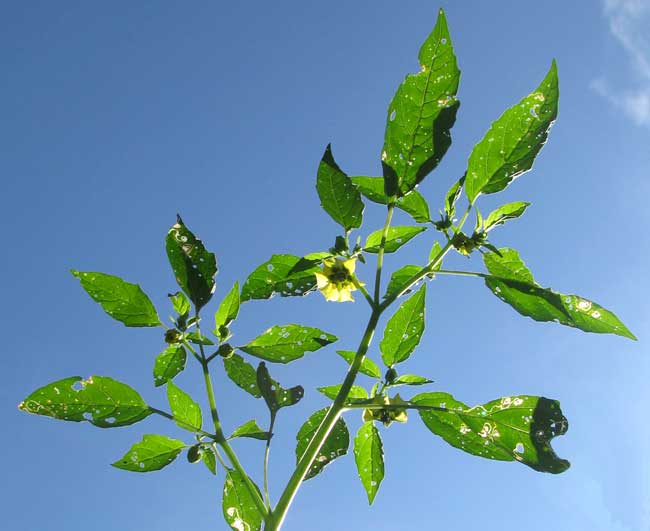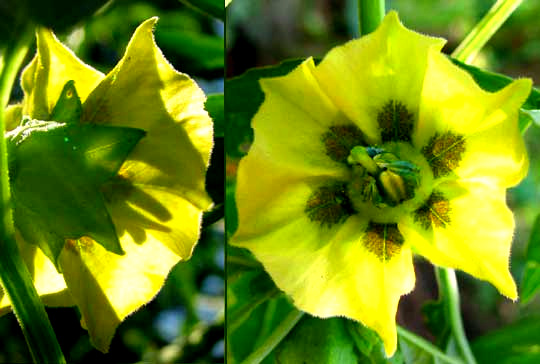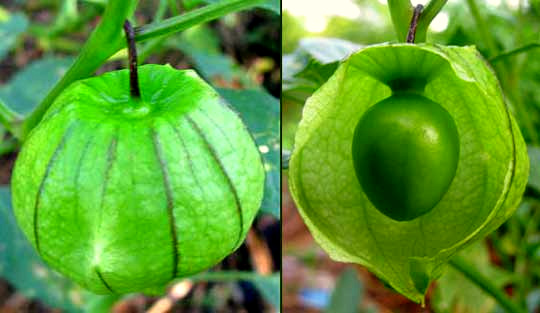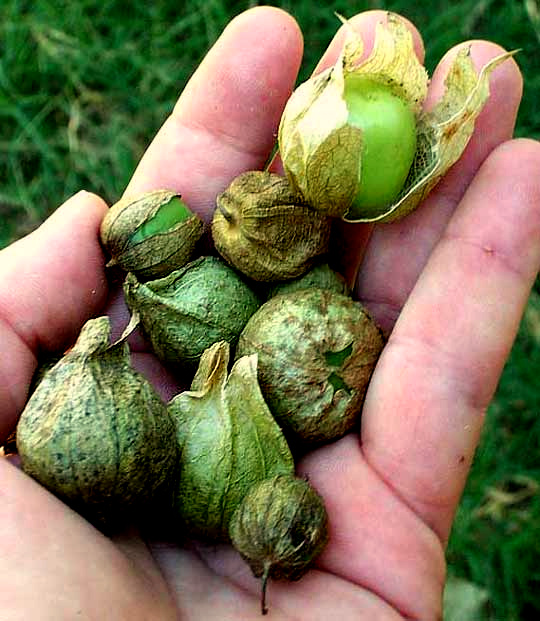Excerpts from Jim Conrad's
Naturalist Newsletter

from the September 5, 2010 Newsletter issued from Hacienda Chichen Resort beside Chichén Itzá Ruins, central Yucatán, MÉXICO
TOMATILLO/ HUSK TOMATO/ TOMATE VERDE
Nematodes are killing all my tomato plants. As if to compensate for that, my Tomatillos, PHYSALIS IXOCARPA of the Nightshade Family, are four feet high (1.2 m), loaded with flowers, and fruits are starting to form. You can see a bug-eaten but vigorous sprout above.
A 3/4-inch wide (1.8 cm) flower -- back side on the left, frontal view on the right -- is shown below:

A back view of the flower is included so you can see the green calyx subtending the yellow corolla. In the genus Physalis the calyx is important because it does something extraordinary: After the flower is pollinated and the ovary begins growing into a fruit, the corolla falls off but the calyx begins enlarging rapidly, soon completely inclosing the fruit. The fruit becomes something like a small, immature, green tomato suspended inside the papery, balloon-like calyx, looking like a Chinese lantern, as shown below:

In that picture the image at the left shows how the "balloon" looks now hanging on the plant. On the right one side of the bladder has been torn away to show the immature, tomato-like fruit suspended inside. Eventually the mature, tasty "tomato" will fill the bladder.
You can imagine the benefit a juicy fruit has from being suspended inside a bladder. Insects can't simply light on the fruit and begin eating or depositing eggs there. Also, the mature fruits of wild Physalis species I know up North fill only a small portion of their bladders, so the bladders are mostly filled with air. When the bladders fall to the ground, fall and early-winter wind often rolls them, with the fruits and seeds inside them, across the ground for long distances -- wind dissemination.
Since regular red tomatoes are in the genus Lycopersicon, you can see that Husk Tomatoes/ Tomatillos, in the genus Physalis, aren't too closely related. However, they do belong to the same plant family, the Black Nightshade Family or Solanaceae, which also holds the potato, tobacco, chili pepper and petunias.
Around here everyone knows about the plant because the fruits are much used in a tasty but not hot, green sauce. They taste so good that I like to just eat them raw, one after the other.
By the way, maybe you noticed that the flower in the picture bore six calyx lobes, or sepals, six corolla lobes and six stamens. Flowers with a symmetry based on six usually are limited to monocotyledonous species such as those in the Lily, Iris and Amaryllis Families. In Nature, Physalis species -- usually weedy, and called ground-cherries or Chinese-lanterns -- almost always bear five-lobed calyxes and corollas, and five stamens. As was the case last week with the Star-Apple flower based on seven -- its symmetry also departing from its normal number five -- horticultural manipulation of important species often screws up the genes so that you get species doing weird things. It's the spots-on-cows phenomenon again.
from the May 12, 2007 Newsletter issued from Sierra Gorda Biosphere Reserve, QUERÉTARO, MÉXICO
TOMATILLO/ HUSK TOMATO/ TOMATE VERDE
In restaurants here typically you have placed onto your table a little wicker basket filled with hot tortillas draped with a white, embroidered cloth, plus they also bring a small, rusty-red, ceramic bowl filled with hot- sauce. Good restaurants give you two bowls, one with green hot-sauce and the other with red.
In Mexico the green hot-sauce is based on fruit of the plant known by the Latin name of PHYSALIS IXOCARPA. In North America we often call the fruits "tomatillos" (toh-mah-TEE-yos) or "husk tomatoes." The latter name is appropriate because the fruits look like small, green tomatoes of the regular sort suspended inside a dry, papery bladder. Hanging on the plant the fruits look like Chinese lanterns. Wild Physalises produce smaller fruits suspended in bladders, and you can visualize what purpose the bladders serve. When the husked fruit falls to the ground, wind blows the bladder around like a tumbleweed, helping the seeds disperse into new territory. In the market this week I bought a handful of husk tomatoes to show you. They're shown below:

Husk tomatoes have been part of indigenous Mexican cuisine for thousands of years, and the last time I was in a US supermarket they were on sale up there, too. The ones up there were nearly the size of regular tomatoes. I think folks here would regard those as too watery and lacking much taste. You can read all about tomatillos or husk tomatoes at http://www.floridata.com/ref/p/phys_ixo.cfm.
The Spanish terms for red tomatoes and husk tomatoes -- which are in the same family but different genera -- can be confusing.
In our part of Mexico the regular, red, huskless tomato is called jitomate (hee-toe-MAH-teh), while husk tomatoes are referred to as tomates (toe-MAH-tehs). However, my Spanish-English dictionary gives only one translation for the English red "tomato," and that's tomate. In the Spanish section my dictionary does list the word jitomate as a special Latin-American Spanish term for "tomato." In fact, in some parts of Mexico they also use tomate for "tomato." So, a red, English tomato is either a jitomate or a tomate, and the husk tomato is either a tomatillo or a tomate, depending on where you are. Several times I've lost my credibility as an effective Spanish-speaker by walking into a market and using the wrong word for tomato.
Of course the words "tomato" and tomate are so similar because "tomato" was derived from the Spanish tomate, which in turn had been taken from the native-Mexican Nahuatl (language of the ancient Aztecs) tomatl -- which was based on the Nahuatl word tomana meaning "to swell." So, tomatoes are "swollen fruits." But who knows whether the Aztecs were talking about red English tomatoes or green husk-tomatoes?